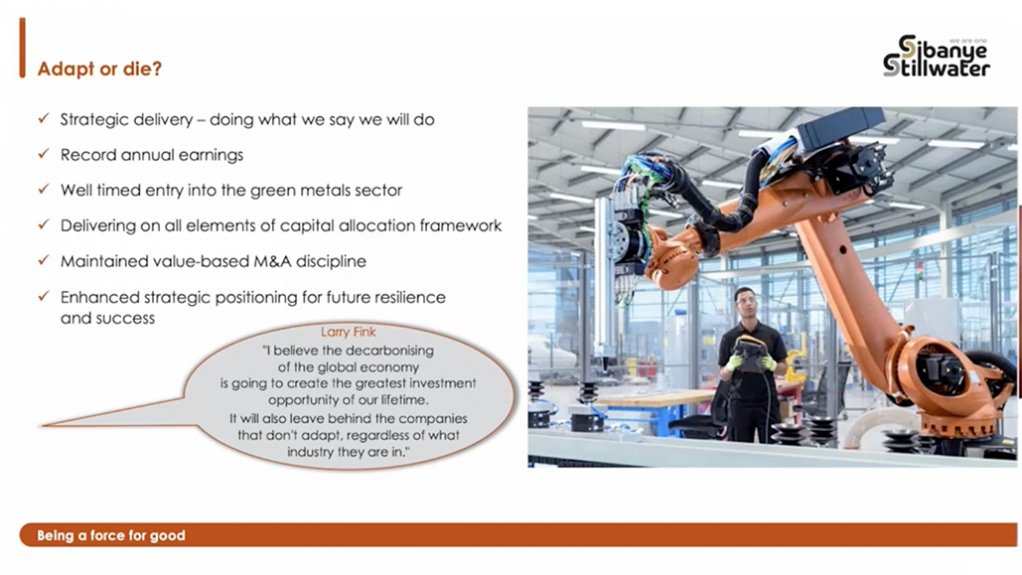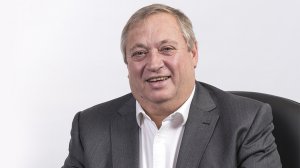JOHANNESBURG (miningweekly.com) – The decarbonising of the global economy to prevent climate change is going to create the greatest investment opportunity of our lifetime.
It will also leave behind the companies that do not adapt – regardless of what industry they are in.
Sibanye-Stillwater CEO Neal Froneman on Thursday quoted these words of Blackrock CEO Larry Fink.
“I think Larry Fink is spot on,” said Froneman during the presentation covered by Mining Weekly that highlighted a stunning set of record-breaking financial results and the declaration “class-leading” dividends. The Johannesburg- and New York-listed company had R11.5-billion net cash in hand as of December 31.
Being a force for good is central to the enhanced strategy of Sibanye-Stillwater, which has already made considerable progress on its own journey towards carbon neutrality, with one solar project in the bag and a total renewables portfolio of 557 MW of solar and wind energy on the way.
Building a green metals portfolio is based on its strategy of building a climate-change-resilient business.
Battery metals, together with the platinum group metals, are poised to provide a significant green metals portfolio, which already takes in investments in lithium- and nickel-producing concerns.
Sibanye-Stillwater intends to complement that with other metals such as copper, perhaps manganese, and uranium, which is a by-product of the gold it mines.
As it increases its exposure to the circular economy, it has advanced its thinking on recycling as well as on mine waste retreatment.
Sibanye-Stillwater energy and decarbonisation head Jevon Martin said as a force for good, Sibanye-Stillwater had a role to play in the urgent global response to the threat of climate change.
“As such, we have aligned our governance strategy and risk management and targets across the group to align with the Task Force on Climate Financial Disclosures,” said Martin.
First and foremost, green metals are produced that support the reduction of greenhouse gases and the reversal of climate change.
Through the introduction of demand-side energy management, renewable energy, electrification, and fuel switching opportunities, including green hydrogen, it believes it will be able to demonstrate an active decarbonisation pathway, which will be converted to internal yearly carbon budgets to inform the long-term incentive plan.
Recognising that there will be hard-to-abate emissions towards the end of its carbon neutral journey, a carbon offset strategy has been compiled to generate the required offsets to neutralise the remaining emissions.
Combining these elements presents a definitive pathway through to carbon neutrality supported by internal carbon budgets to drive decarbonisation and deliver on commitments.
Owing to the infrastructure and extensive energy requirements of South African operations, combined with the carbon intensive electricity supply from Eskom, 93% of the company’s greenhouse gas emissions emanate from grid-supplied electricity.
“Eskom also continues to pose a risk to our business through above inflation tariff increases and unreliable electricity supply.
“The extensive electrification of operations, however, presents an opportunity to mitigate these risks and accelerate decarbonisation through the deployment of renewable energy,” said Martin.
Relaxing of regulatory requirements and anticipated ability to trade electricity in South Africa, has allowed Sibanye-Stillwater to grow its portfolio of renewable projects to 557 MW, including solar and wind projects.
A local project developer has been appointed to provide 50 MW of solar photovoltaic electricity to its South African gold operations as well as two local project developers for three shovel-ready wind projects across South Africa.
Progress has also been made in the permitting and consents required for a solar project at South African platinum group metals operations.
“These projects have been structured to limit capital outlay whilst enabling significant decarbonisation and savings benefits,” said Martin.
Anticipated capital cost of the project is anticipated to be around R11-billion and will be funded by third parties through power purchase agreements.
The projects would enable a 25% reduction in Scope 2 emissions by 2025 and deliver substantial operational benefits, Martin added.
The plan is to also leverage these projects to promote local socioeconomic development.
“The projects will also contribute in the closing of the South African electricity supply deficit and bring an end to load-shedding to the benefit of all South Africans and the economy,” said Martin.
Outlining impending high impact global issues – or what he described as being grey elephants – Froneman decried the fact that some people were still disputing the issue of climate change.
“Just about every one of these grey elephants lead to angry people and the climate emergency has no nationality, no race, no sexual preference, and certainly no political or religious affiliation. It’s real, and the transition we're in will create completely new global tensions.
“And again, like with most of these things, it's the poorer people in the world that suffer from an angry planet. As a business, we have adjusted our strategy to build climate-change-resilient businesses, and to provide metals that are at the forefront of reversing climate change, said Froneman, who added that, very importantly, together with shareholders, commitments are being made to invest in social upliftment to avoid the grey elephant of angry people, “and be a force for good”.
Displaying a slide headlined ‘Adapt or die?, he said he had no doubt that Sibanye-Stillwater would be a force for good.
On Finks' assertion that not adapting would lead to company failure, irrespective of the industry, Froneman said: "We are certainly going to be one of those companies that prosper.”
Sibanye-Stillwater's normalised earnings for 2021 increased by 27% to R38.9-billion ($2.6-billion) year-on-year, driven by the strong first-half performance, with normalised second-half earnings of R14.5-billion ($963-million) 34% lower than for the second half of 2020. This was primarily owing to a sharp decline in precious metals prices during the period, the company stated.
The board approved a final dividend for the second half of R5.3-billion ($342-million) or R1.87 a share, which is at the upper end of the group dividend policy range of 25% to 35% of normalised earnings.
Together with the record first-half interim dividend of R8.5-billion ($565-million), this represents a leading yearly
dividend yield of 9.8% for 2021. In addition to the record dividends, 5% of issued capital was repurchased between June and October.
EMAIL THIS ARTICLE SAVE THIS ARTICLE ARTICLE ENQUIRY
To subscribe email subscriptions@creamermedia.co.za or click here
To advertise email advertising@creamermedia.co.za or click here












